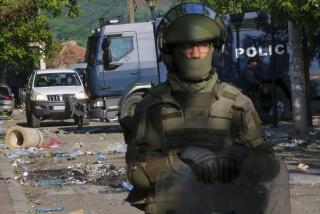Bosnia Troops Mass Near Capital, Fuel Fear : Balkans: Buildup northwest of Sarajevo could spark bloodiest battle yet. Some suggest it may be bluff or decoy.
- Share via
SARAJEVO, Bosnia-Herzegovina — Frustrated by the United Nations’ impotence and the West’s indifference, Bosnian officials are talking openly and enthusiastically about high-risk plans to break the 38-month siege of this devastated capital.
Such an operation would likely trigger the biggest, bloodiest battle of the Bosnian war, in which an estimated 200,000 have already died.
Rumors that an offensive might be imminent took on new life Wednesday after reports of massive Bosnian government troop concentrations 12 miles northwest of Sarajevo.
But military analysts and diplomats caution that the buildup between the highland towns of Breza and Visoko may in fact have other objectives.
It may be a decoy intended to draw enemy Bosnian Serb troops from other positions. Or it may be a bluff intended to force action by an always reluctant international community.
In Washington, the Clinton Administration took the maneuvering seriously.
U.S. officials formally urged Bosnia’s government not to proceed with its plan to mount a major new military offensive around Sarajevo, but there was no indication that the appeal would be effective.
Secretary of State Warren Christopher delivered the message in a private breakfast with Bosnian Prime Minister Haris Silajdzic but apparently received no assurances that Bosnian government troops would cancel any military plans.
A few hours after the early meeting, Silajdzic cut short what had amounted to a weeklong visit to the United States and left for Sarajevo, saying there was a need to protect the Bosnian capital.
A few hours later, after a meeting with new French President Jacques Chirac, President Clinton publicly buttressed Christopher’s point, telling a news conference that “we have discouraged all the parties from continued violence.”
“The question here is . . . would [a new military offensive by the Bosnian Muslims], even if it could succeed, ultimately strengthen or weaken the efforts of [the U.N. peacekeeping force] to strengthen itself?” Clinton asked rhetorically.
“The sympathies of the United States and this Administration are with the struggle of the Bosnian government to preserve the territory,” he said. “In the end, a military solution is not available to the Bosnian government, and I’m quite concerned about it.”
Breaking the Sarajevo siege, in which Bosnian Serbs have blocked food, electricity, water and medical supplies to this once-cosmopolitan city, would be a herculean task with numerous casualties, analysts warn.
The Bosnian government’s army outnumbers but is outgunned by the Bosnian Serb army, which would probably renew the kind of brutal shelling that left Sarajevo in ruins in 1993.
Although better trained and better armed than it was a year ago, the government army remains untested and may not have the skills to mount the fierce house-to-house combat that breaking the siege would involve, experts said.
If the Bosnian government’s exact intentions and capabilities are not clear, the level of frustration here is.
“We have two ways to go: Either the international community breaks the siege or we have to do it,” a senior Bosnian military officer told The Times. “We cannot go through another winter like this. Look at us. We have no electricity. No water. We cannot wash. . . . You cannot feed your children. We have people rummaging through garbage cans for food. The city will die if the siege is not broken this year.”
An estimated 10,000 to 20,000 troops from the 1st Corps of the Bosnian army are massing north of Sarajevo, U.N. officials say. Hospitals are reported to have been cleared and schools closed, all signs of an impending offensive.
Yet the publicity surrounding the troop movement seems to cast doubt over how imminent an offensive really is.
Bosnian President Alija Izetbegovic last month pledged to end the siege by force before winter if U.N. peacekeeping troops had not succeeded in assisting the city. Those comments have been echoed by several other officials, including Sarajevo Mayor Tarik Kupusovic.
Vice President Ejup Ganic, however, sought to lower expectations Wednesday.
He said troops being moved into the Visoko-Breza area number only several thousand and are intended not to attack but to protect the city.
“If we had enough weapons now, I would launch the liberation of Sarajevo now,” Ganic said. “But we don’t have enough.”
Bosnian officials are especially alarmed by the Bosnian Serbs’ recovery of almost 300 heavy artillery pieces from warehouses that were guarded by U.N. peacekeepers.
When rebel Serbs recently took peacekeepers hostage, they also took the weapons.
In some cases, they did not relocate the mortars and rockets, and are firing them from collection sites.
The sites were once part of a U.N. “weapons exclusion zone” meant to protect Sarajevo from heavy armament.
The Bosnian Serbs used the hostage crisis to take over the weapons and render the U.N. protection worthless.
One of the collection points, Osijek, just west of the capital, “is in effect a large gun position with commanding views over the airport of Sarajevo,” U.N. spokesman Lt. Col. Gary Coward said Tuesday.
The Bosnian Serb army numbers about 80,000, with 12,000 troops dug in around Sarajevo. Besides a large stock of heavy weapons, its advantages include a good command and control structure and experience in modern mechanized warfare.
But it is short on ammunition and fuel because of a partial embargo imposed by its former patron, Serbia.
The Bosnian government army, on the other hand, lacks experience but, in the words of one analyst, has “lots of men, lots of guts.”
It has armed itself in the last year, despite an international arms embargo, with the help of sympathetic governments such as Iran. But it still lacks substantial heavy weaponry.
Times staff writer Art Pine in Washington contributed to this report.
More to Read
Sign up for Essential California
The most important California stories and recommendations in your inbox every morning.
You may occasionally receive promotional content from the Los Angeles Times.











